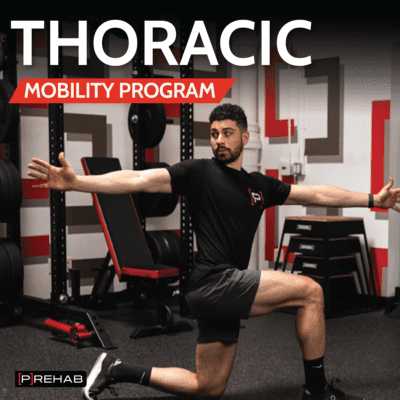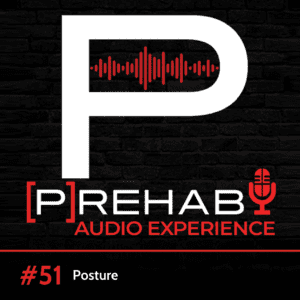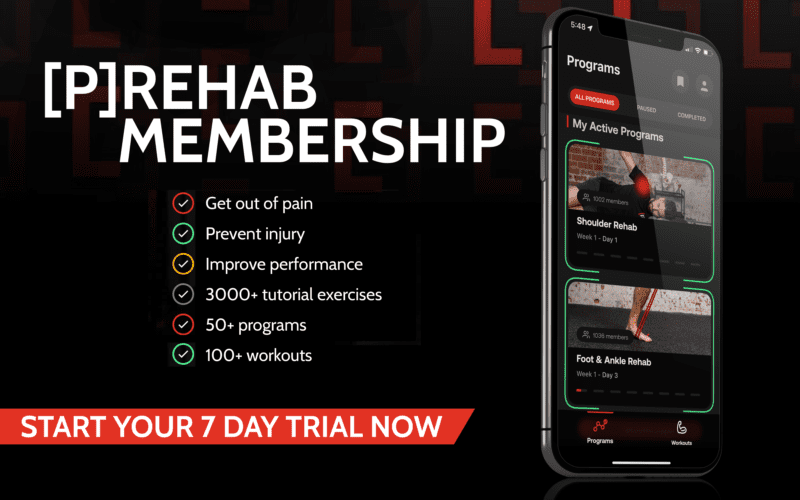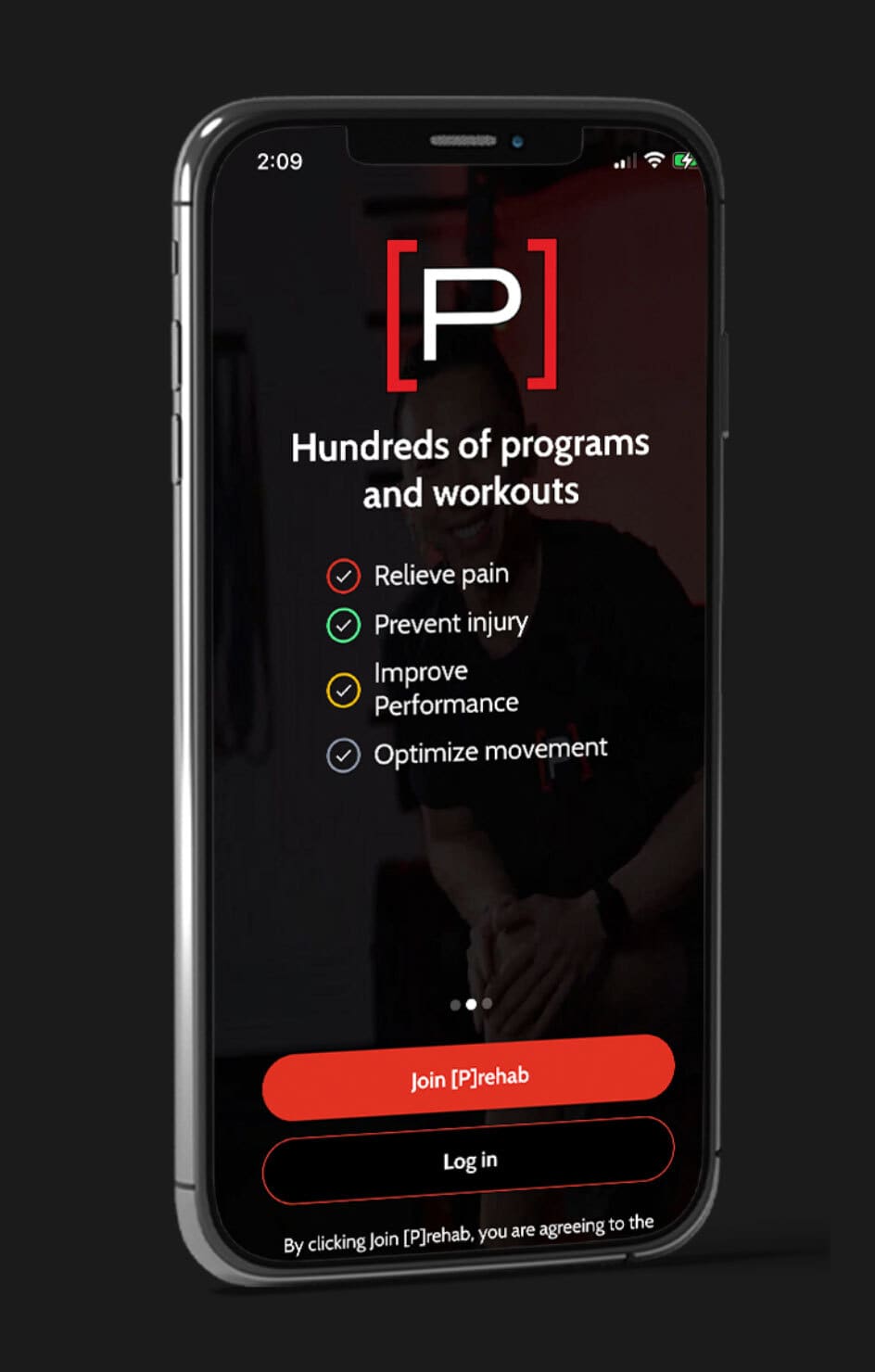When it comes to mid back and scapular pain, nothing beats a mid back prehab program with tons of thoracic spine mobility and stability work. Mid back pain can be caused by a variety of structures in the mid back itself like the thoracic spine, ribs, or trigger points in the upper back muscles. Furthermore, the pain could even originate from other regions, not in the mid back like the neck or shoulders. That’s a lot of potential pain generators and triggers! Making matters even more complicated is that it’s oftentimes difficult to recreate a “trigger”. In physio terms, a trigger is something that causes your familiar pain. Meaning if you ask yourself the question, “what typically causes my mid-back pain?” The answer for many with mid-back pain is typically something vague and difficult to pinpoint. “Uh, this weird position I put my arms in… it just aches… it’s always there, etc.” Don’t worry, this is common! But because of this conundrum, you can never go wrong with a holistic mid back prehab program focused on improving thoracic spine mobility and strength and above all else, keeping moving! Follow along in this article as you learn the best exercises for mid back pain!
Mid Back Pain? Desensitize Your Triggers and Move!
If you currently have mid back pain, before we [P]Rehab – we must rehab. The goal of rehab is to desensitize your mid back to those “triggers” we talked about earlier. And even if you don’t have any clear movement-based triggers, introducing general mobility into the mid back in a graded manner is always step one before progressing to more advanced exercises!
Open Up Your Stiff Mid Back
Do you feel that you constantly have mid back stiffness and/or discomfort? If so, we have the solution for you! This mid back program is the ultimate program that will teach you how to open up that stiff mid back of yours.
Mobility Exercises For Mid Back Pain
The cat cow is my go-to for desensitization. It’s a movement that is inherently easy to control if you have pain. And if you don’t, it just simply feels good. For mid back pain, the key is to bias the mid back region during the cat cow movement rather than the low back region.
Cat Cow Thoracic Spine Bias
Sample Thoracic Spine [P]rehab Program Exercise
Thread The Needle To Open Book
Sample Thoracic Spine [P]rehab Program Exercise
Thread the needle is an all-time winner when it comes to the best exercises for mid back pain. This exercise combines a thread the needle with an open book exercise to hit rotation in both directions. The secret to unlocking more mobility through your thoracic spine is to use your eyes when turning! Notice how I look in the direction I want to turn. You’ll find yourself getting more degrees of rotation in any exercise by guiding yourself with your eyes!
Also, notice how I use my fingers to “get a little extra rotation” during the thread of the needle. Try to get as much rotation actively as you can on your own first. Then, use your fingers to gain a couple more degrees of rotation as you exhale and relax your body. You can also use a foam roller like in this video to get more rotation.
If putting weight through your shoulder/wrist is an issue, a simple solution is to lie on your side and perform just the side-lying open book exercise. You’ll want to perform it on both sides.
LISTEN: IMPROVING POSTURE WITH [P]REHAB
Mid Back Foam Rolling
Sample Thoracic Spine [P]rehab Program Exercise
If you don’t have a foam roller, simply use a towel roll against a chair. This is a great alternative if you have issues getting up and down off the ground as well!
Learn Mobility Exercises For Your Stiff Back!
Mobilize – Then Strengthen
After mobilizing, a mid back prehab program wouldn’t be complete without some properly dosed strengthening and loading to build a strong back! I’ve included some of my go-to exercises for building up a strong back – you’ll notice that strengthening the mid-back essentially means the entire pillar from the shoulders to the hips. Furthermore, your strengthening exercises should address all three planes of motion (sagittal, frontal, and transverse).
Prone Snow Angels
I’m a big fan of any prone swiss ball work as your entire back must actively be on to stabilize your pillar. It’s a great entry-level exercise if you currently have mid back pain that hopefully shouldn’t aggravate any of your symptoms. Adding the snow angel component also hits many of the scapular stabilizers like the traps and rhomboids.
Mid Back Strengthening Exercises Can Help Too!
Any front rack squat/lunge like a goblet squat, Zercher squat, or front squat will force your mid back muscles to turn on to maintain proper positioning. Again, it’s a very easy way to learn to turn your mid back muscles by simply holding a weight in front of you while doing a leg exercise you are comfortable with. The key is to not let the weight pull you down. Your goal is to try to maintain an upright position!
Kettlebell Goblet Squat
The Prehab membership is the anti-barrier solution to keeping your body healthy. Access state-of-the-art physical therapy, fitness programs, and workouts online in the comforts of your own home or gym! Taking control of your health with exercise & education from the palm of your hand has never been easier. Get access to 50+ programs, 100+ unique workouts, and 3000+ exercises to build your own workout routines. Trial it for free, and learn how to get out of pain, avoid injury, and optimize your health with [P]rehab!
Barbell Deadlift
Working up to a weighted barbell deadlift would be the ultimate holy grail when it comes to mid back prehab. But if you’re not comfortable with a barbell deadlift, there are still tons of other deadlift variations you can perform without a barbell that will strengthen your mid back similarly!
READ: DEADLIFT WARMUP ESSENTIALS
What About My Posture And My Mid Back Issues?
Mid back pain can definitely be posture related. Long days of sitting. Computer work. Driving. Studying. Reading. Gaming. Want to know what’s similar between all the previous examples?
A lack of movement
Improving your posture can be as simple as taking movement breaks throughout the day! It doesn’t have to be a long 15-minute walk around the office (although that would be great!), and can easily be taking a standing break for 10 seconds. Or simply shifting from an upright sitting posture to a reclined sitting posture. Movement is medicine! Check out some of these stretches you can do at your desk below!
Work Stretches for Mid Back Prehab
And remember, your posture does not have to be perfect! Check out this video by Dr. Greg Lehman on why perfect posture does not exist!
Closing Thoughts
There are a variety of exercises that can be implemented to improve the overall quality of mid back health. This includes a combination of mobility exercises, motor control, stability exercises, functional movements, and strengthening! Most importantly above all is to keep yourself moving and move often!
Take Control of Your Thoracic Spine Mobility!
When we think of the thoracic spine one word comes to mind; neglect. Thank you for striving to replace that word by completing this program! The thoracic spine is structurally designed to allow mobility to happen. If this area becomes neglected, the lower back and shoulders can become angry neighbors. The solution becomes restoring peace in the neighborhood by owning thoracic mobility. The block party is 8 weeks away and you hosting the thoracic spine, get ready to impress your neighbors!
About The Author
Michael Lau, PT, DPT, CSCS
[P]rehab Co-Founder & Chief Product Officer











